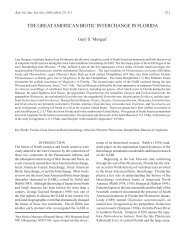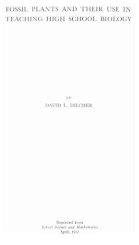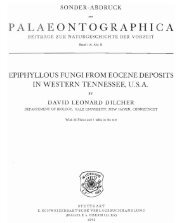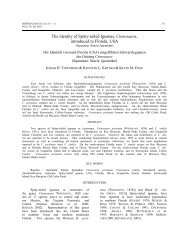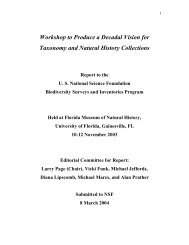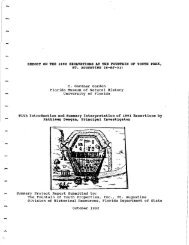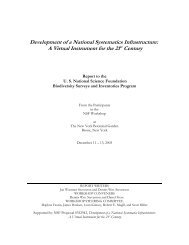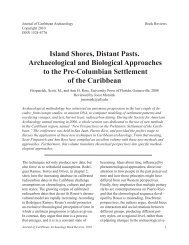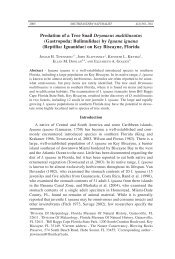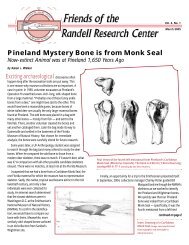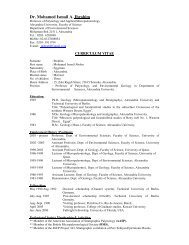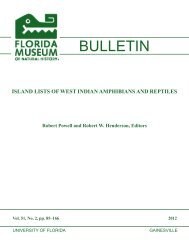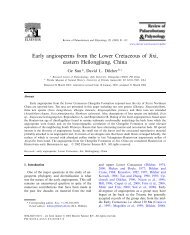COMPOSITIONAL ANALYSIS OF FRENCH COLONIAL CERAMICS ...
COMPOSITIONAL ANALYSIS OF FRENCH COLONIAL CERAMICS ...
COMPOSITIONAL ANALYSIS OF FRENCH COLONIAL CERAMICS ...
You also want an ePaper? Increase the reach of your titles
YUMPU automatically turns print PDFs into web optimized ePapers that Google loves.
Compositional Analysis of French Colonial Ceramics Kelly et al.<br />
commonly observed mineral inclusions were<br />
volcanic rock fragments, monomineral<br />
plagioclase feldspars, quartz, hornblende, and<br />
biotite. For the most part, the ceramic<br />
petrography results were concordant with the<br />
INAA, but also served to identify additional<br />
mineralogical variation within the defined<br />
chemical groups.<br />
Petrographically, Group 1 appears to be a<br />
tightly clustered group of ceramics and<br />
includes wheel-thrown domestic pottery<br />
(n=10), and industrial ceramics (n=9). The<br />
sites represented in this group include Grande<br />
Pointe, Grande Anse River Mouth, Grande<br />
Anse, Grande Baie, and La Mahaudière, all in<br />
Guadeloupe. Petrographically, members of<br />
this group are relatively similar, and<br />
diagnostic inclusions within the clay matrix<br />
are volcanic clasts (0.5 to 0.75mm), quartz<br />
fragments with undulatory (0.05mm)<br />
extinction and plagioclase feldspar (0.05 to<br />
0.1 mm), (Figure 10). There is some variation<br />
in the clastic inclusions, including one variant<br />
that contained fine-grained clasts with large<br />
feldspar inclusions. These inclusions are<br />
identified as rhyolite. These ceramics include<br />
industrial ceramics (n=5), and domestic<br />
wheel thrown ceramics (n=3) from La<br />
Mahaudière, Grande Anse, and Trois<br />
Rivières. The second variant contains more<br />
coarse grained clasts within a poikalitic<br />
texture with volcanic glass (approx. 1 mm),<br />
plagioclase feldspar (0.1 to 0.2 mm). There<br />
are also accessory pyroxenes in the clay<br />
matrix. These samples include wheel thrown<br />
domestic ceramics (n=4) and industrial<br />
ceramics (n=7) from La Mahaudière, Grande<br />
Anse, and Grande Pointe.<br />
Ceramics identified as Group 2 contain<br />
domestic hand-built pottery (n=6), domestic<br />
wheel-thrown pottery (n=7), and industrial<br />
ceramics (n=3) from Grande Pointe,<br />
Guadeloupe (n=1), Macabou (n=1), Morne<br />
Cabrit (n=6), Pointe Petite Poterie (n=4),<br />
Trois Ilets (n=2) and Pointe Borgnesse (n=2).<br />
Petrographically, this cluster of ceramics is<br />
defined by the large presence of amphiboles<br />
identified as hornblende, plagioclase, quartz<br />
with undulatory extinction, orthopyroxenes,<br />
augite, and the accessory minerals of calcite,<br />
magnetite, and garnets (Figure 11). The<br />
mineral assemblage of these ceramics is<br />
consistent with the geology of Martinique, as<br />
well as pre-Columbian ceramics previously<br />
described by Walters (1991) and England<br />
(1994). Samples identified as unassigned by<br />
MURR are included in this group,<br />
specifically three from Pointe Borgnesse<br />
(GUA 16, 17, 19), one from Trois Ilets (GUA<br />
27), and one from Rue Dumanoir.<br />
We recorded three variants in this cluster of<br />
ceramics through petrography. The first<br />
variant includes industrial ceramics from<br />
Morne Cabrit and Trois Ilets (n=3) in<br />
Martinique. This variant contains large<br />
hornblende inclusions that comprise 15% of<br />
the counted inclusions. Samples also contain<br />
quartz (approx. 50%) and plagioclase<br />
feldspar inclusions (approx. 25%). The<br />
hornblende shows signs of hemical<br />
deformations and range in size from 0.25 to 1<br />
mm. The quartz is simple angular and<br />
exhibits undulatory extinction. The<br />
plagioclase feldspar exhibits deformed<br />
carlsbad twinning indicating regional<br />
metamorphism.<br />
The second variant is dominated by<br />
domestic wheel-thrown ceramics from Trois<br />
Ilets (n=1), Morne Cabrit (n=3), Pointe Petite<br />
Poterie (n=2), and Pointe Borgnesse (n=3),<br />
(all from Martinique). This group contains<br />
quartz (approx. 50%), plagioclase feldspar<br />
(approx 20%), and biotite (approx. 10%). The<br />
quartz is between 0.25 and 0.5 mm and<br />
Journal of Caribbean Archaeology, Special Publication #2, 2008 100



